
Aflatoxins are various poisonous carcinogens and mutagens that are produced by certain molds, particularly Aspergillus species. The fungi grow in soil, decaying vegetation and various staple foodstuffs and commodities such as hay, sweetcorn, wheat, millet, sorghum, cassava, rice, chili peppers, cottonseed, peanuts, tree nuts, sesame seeds, sunflower seeds, and various spices. In short, the relevant fungi grow on almost any crop or food. When such contaminated food is processed or consumed, the aflatoxins enter the general food supply. They have been found in both pet and human foods, as well as in feedstocks for agricultural animals. Animals fed contaminated food can pass aflatoxin transformation products into eggs, milk products, and meat. For example, contaminated poultry feed is the suspected source of aflatoxin-contaminated chicken meat and eggs in Pakistan.
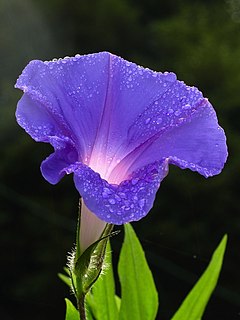
Morning glory is the common name for over 1,000 species of flowering plants in the family Convolvulaceae, whose current taxonomy and systematics are in flux. Morning glory species belong to many genera, some of which are:

Linaria is a genus of almost 200 species of flowering plants, one of several related groups commonly called toadflax. They are annuals and herbaceous perennials, and the largest genus in the Antirrhineae tribe of the plantain family Plantaginaceae.

Aspergillus flavus is a saprotrophic and pathogenic fungus with a cosmopolitan distribution. It is best known for its colonization of cereal grains, legumes, and tree nuts. Postharvest rot typically develops during harvest, storage, and/or transit. Its specific name flavus derives from the Latin meaning yellow, a reference to the frequently observed colour of the spores. A. flavus infections can occur while hosts are still in the field (preharvest), but often show no symptoms (dormancy) until postharvest storage or transport. In addition to causing preharvest and postharvest infections, many strains produce significant quantities of toxic compounds known as mycotoxins, which, when consumed, are toxic to mammals. A. flavus is also an opportunistic human and animal pathogen, causing aspergillosis in immunocompromised individuals.

Asphodelus fistulosus is a species of plant known as hollow-stemmed asphodel, onionweed, onion-leafed asphodel, and pink asphodel. It is native to the Mediterranean region. It is an invasive exotic weed in the United States, with significant infestations in California, Arizona, New Mexico, and Texas. It is listed as a Federal Noxious Weed by the United States Department of Agriculture. It is also a common weed in parts of Australia, New Zealand, and Mexico, and it thrives in any area with a Mediterranean climate.

Ipomoea purpurea, the common morning-glory, tall morning-glory, or purple morning glory, is a species in the genus Ipomoea, native to Mexico and Central America.

Nuttallanthus is a genus of four species of herbaceous annuals and perennials that was traditionally placed in the foxglove family Scrophulariaceae. Due to new genetic research, it has now been placed in the vastly expanded family Plantaginaceae. Three species of Nuttallanthus are native to North America and one to South America. Nuttallanthus was until the 1980s included in a wider circumscription of the genus Linaria, a genus now considered restricted to the Old World.

Linaria vulgaris, the common toadflax, yellow toadflax or butter-and-eggs, is a species of flowering plant in the family Plantaginaceae, native to Europe, Siberia and Central Asia. It has also been introduced and is now common in North America.

Nuttallanthus canadensis, the blue toadflax, Canada toadflax, or old-field toadflax, is a species of Nuttallanthus in the family Plantaginaceae, native to eastern North America from Ontario east to Nova Scotia and south to Texas and Florida.

Verbena bonariensis, the purpletop vervain, clustertop vervain, Argentinian vervain, tall verbena or pretty verbena, is a member of the verbena family cultivated as a flowering annual or herbaceous perennial plant. In USA horticulture, it is also known by the ambiguous names purpletop and South American vervain. For the misapplication "Brazilian verbena" see below.
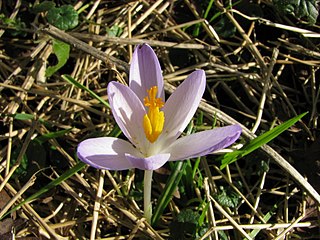
Crocus tommasinianus, the woodland crocus, early crocus, or Tommasini's crocus, was named after the botanist Muzio G. Spirito de Tommasini (1794-1879). It is native to Bulgaria, Hungary, Albania, and the former Yugoslavia. It is often referred to as the early or snow crocus, but these terms are shared with several other species, although C. tommasinianus is amongst the first to bloom. Multiple plants are often called tommies in the horticultural trade.
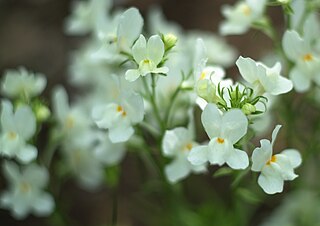
Linaria bipartita is a species of flowering plant in the plantain family known by the common name clovenlip toadflax. It is native to Morocco, but it can be found elsewhere as an introduced species and it is cultivated as an ornamental plant. It is an annual herb growing 10 to 30 centimeters tall with linear leaves 3 to 5 centimeters in length. The inflorescence is a raceme of flowers occupying the top of the stem. The flower is about 2 centimeters long with five lobes arranged into two lips with a spur at the end. The flower is often reddish purple in color, but flowers of many different colors are bred for the garden. The fruit is a spherical capsule about 2 millimeters wide.

Linaria maroccana is a species of flowering plant in the plantain family known by the common names Moroccan toadflax and annual toadflax. It is native to Morocco, but it can be found elsewhere growing wild as an introduced species, such as California. It is a readily available ornamental plant for the flower garden. This is an annual herb growing erect to approach a maximum height of 50 cm (20 in), its stem with linear leaves 2–4 cm (0.8–1.6 in) long. The inflorescence is a raceme of flowers occupying the top of the stem. At the base of each flower is a calyx with five narrow, pointed lobes. The flower is 2–4 cm (0.8–1.6 in) long with five lobes arranged into two lips with a spur at the end. The flower is often purple in color with white near the throat, but flowers of many different colors are bred for the garden. Dwarf cultivars are also available.
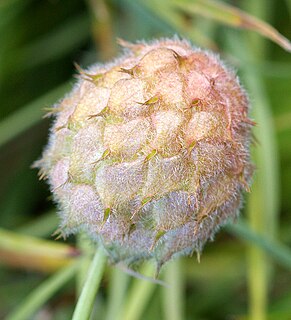
Trifolium fragiferum, the strawberry clover, is a herbaceous perennial plant species in the bean family Fabaceae. It is native to Europe, Asia, and parts of Africa. It is present in other places, such as sections of North America, as an introduced species. It is also cultivated as a cover crop and for hay and silage, as green manure, and as a bee plant.
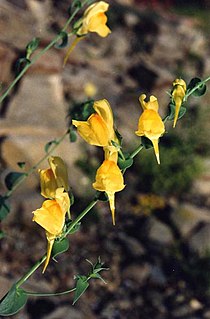
Linaria dalmatica is a herbaceous plant native to western Asia and southeastern Europe that has become a weed in other areas. Its common names include Balkan toadflax, broadleaf toadflax, and Dalmatian toadflax.
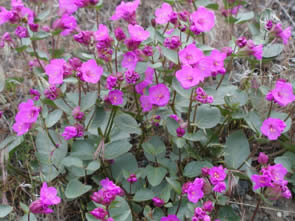
Mirabilis macfarlanei is a rare species of flowering plant in the four o'clock family known by the common name MacFarlane's four o'clock. It is native to Idaho and Oregon in the United States, where it is only known from three river canyons. It faces a number of threats and is federally listed as a threatened species of the United States.

Aspergillus parasiticus is a fungus belonging to the genus Aspergillus. This species is an unspecialized saprophytic mold, mostly found outdoors in areas of rich soil with decaying plant material as well as in dry grain storage facilities. Often confused with the closely related species, A. flavus, A. parasiticus has defined morphological and molecular differences. Aspergillus parasiticus is one of three fungi able to produce the mycotoxin, aflatoxin, one of the most carcinogenic naturally occurring substances. Environmental stress can upregulate aflatoxin production by the fungus, which can occur when the fungus is growing on plants that become damaged due to exposure to poor weather conditions, during drought, by insects, or by birds. In humans, exposure to A. parasiticus toxins can cause delayed development in children and produce serious liver diseases and/or hepatic carcinoma in adults. The fungus can also cause the infection known as aspergillosis in humans and other animals. A. parasiticus is of agricultural importance due to its ability to cause disease in corn, peanut, and cottonseed.

Aflatoxin M1 is a chemical compound of the aflatoxin class, a group of mycotoxins produced by three species of Aspergillus - Aspergillus flavus, Aspergillus parasiticus, and the rare Aspergillus nomius - which contaminate plant and plant products.

Linaria repens, also known as pale toadflax or creeping toadflax in Europe and as striped toadflax in the US, is an herbaceous plant in the family Plantaginaceae, native to Europe.
Lobelia feayana, the bay lobelia, is a species of bellflower endemic to Florida. A perennial dicot in the Campanulaceae family, it grows in moist areas such as ditches and is often spotted along roadsides. When clustered, the flowers have been described as appearing as a purple haze. It is pollinated by bees and the colors of the five petaled flowers vary from "bluish to lavender to purplish-pink". It is sometimes mistaken for blue toadflax which can also grow in groupings.



















